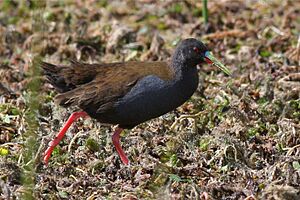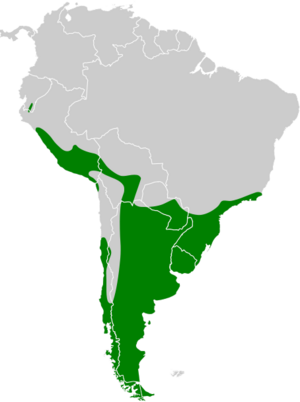Plumbeous rail facts for kids
Quick facts for kids Plumbeous rail |
|
|---|---|
 |
|
| Conservation status | |
| Scientific classification | |
| Genus: |
Pardirallus
|
| Species: |
sanguinolentus
|
 |
|
| Synonyms | |
|
|
The plumbeous rail (Pardirallus sanguinolentus) is a type of bird found in South America. It belongs to the rail, crake, and coot family, called Rallidae. You can find this bird in many countries, including Argentina, Bolivia, Brazil, Chile, Ecuador, Paraguay, Peru, and Uruguay. It often lives near water, like marshes and ponds.
Contents
Understanding the Plumbeous Rail Family Tree
Scientists group living things to understand them better. The plumbeous rail has been placed in different bird groups over time. Some experts even think it might be the same species as the blackish rail. These two birds are very closely related.
There are six different types, or subspecies, of the plumbeous rail. They are:
- P. s. simonsi
- P. s. tschudii
- P. s. zelebori
- P. s. sanguinolentus (This is the main type)
- P. s. landbecki
- P. s. luridus
What Does a Plumbeous Rail Look Like?
Plumbeous rails are medium-sized birds. They are about 30 to 38 centimeters (12 to 15 inches) long. They weigh between 170 to 230 grams (6 to 8 ounces). Both male and female birds look very similar.
These birds have bright red eyes and red legs. Their beaks are green. Most plumbeous rails have a sky-blue color at the base of their upper beak. Their lower beak is bright red.
The main type, P. s. sanguinolentus, has mottled brown feathers on its back. Its face and belly are plain gray. Other subspecies might be slightly different in size or feather color. For example, P. s. luridus is the largest, and P. s. zelebori is the smallest. Some subspecies have lighter gray bellies or less mottling on their backs.
Where Do Plumbeous Rails Live?
The plumbeous rail lives in various parts of South America. It lives further south than any other rail species on the continent.
Each of the six subspecies lives in a specific area:
- P. s. simonsi: Lives along the Pacific coast from southern Ecuador, through Peru, and into northern Chile.
- P. s. tschudii: Found in southeastern Peru and parts of central and southeastern Bolivia.
- P. s. zelebori: Lives in southeastern Brazil.
- P. s. sanguinolentus: Found in southeastern Brazil, Paraguay, Uruguay, and Argentina.
- P. s. landbecki: Lives in central Chile and southwestern Argentina.
- P. s. luridus: Found in southern Chile and Argentina, including Tierra del Fuego. Sometimes, it even wanders to the Falkland Islands.
These birds love places with water and lots of plants. You can find them in reed marshes, ponds with floating plants, and even wet ditches near farms. They usually live in low-lying areas. However, they can sometimes be found in mountains as high as 2,500 meters (8,200 feet). In a few spots, they live at about 4,000 meters (13,000 feet) high.
Ancient History: Plumbeous Rail Fossils
Scientists have found old bones, called fossils, of the plumbeous rail. These fossils date back to the Late Pleistocene and early Holocene periods. They were discovered in Chile. This shows that these birds have lived in South America for a very long time!
Plumbeous Rail Behavior
How Plumbeous Rails Move Around
We don't know everything about how plumbeous rails move. Some groups of these birds, like those near the Atlantic coast, tend to stay in one place. Others, especially those that nest in the Argentine Pampas, might travel north during the winter months.
What Plumbeous Rails Eat
Plumbeous rails mostly look for food around dawn and dusk. But they can also be active during the day and night. They eat small creatures like grubs, worms, and insects. They find their meals in marshes, ponds, and nearby farm fields.
Reproduction and Life Cycle
The breeding season for plumbeous rails changes depending on where they live. Generally, it happens between October and January. The birds build a simple nest of dry grass. They place it on the ground among bushes or tall grass, usually close to water.
A female plumbeous rail usually lays four to six eggs. We don't know exactly how long it takes for the eggs to hatch or for the young birds to be ready to fly.
Plumbeous Rail Sounds
Male plumbeous rails sing a series of high, loud, rolling squeals. Females join in with low, deep "hoo" notes. They can sing at any time of day. They also make calls that sound like repeated "giyp" or "wit" notes.
Is the Plumbeous Rail in Danger?
The IUCN (International Union for Conservation of Nature) has looked at the plumbeous rail. They have decided it is a species of "Least Concern." This means it is not currently in danger.
The bird lives across a very large area. Even though we don't know the exact number of plumbeous rails, their population seems to be stable. There are no immediate threats that scientists have found. It can be hard to count them in some places, but they are common in others. Scientists think there might be even more plumbeous rails than we currently know!


